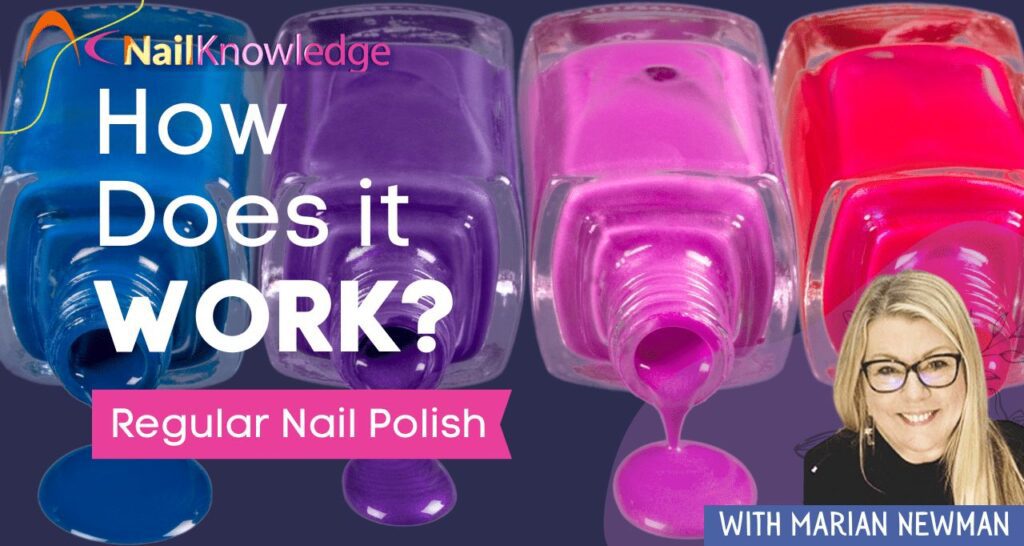In this enlightening journey, we will unravel the captivating world of nail polish and how it works, diving deep into its composition, application techniques, and the mesmerising process of drying. We’ll decode the essential ingredients that transform liquid polish into a glossy masterpiece and understand the factors that influence its longevity.
What is Nail Polish?
Nail polish, also known as nail varnish, nail enamel, or nail lacquer, is a cosmetic product specifically designed for painting and decorating the nails. It comes in a wide array of colors, finishes, and formulations, making it a versatile accessory for people of all ages and styles.
The Popularity of Nail Polish as a Cosmetic Product.
A History of Beauty and Self-Expression
Nail polish has a rich history dating back to ancient civilizations. It was used by the Egyptians, Chinese, and other cultures as a form of self-expression and a symbol of social status. Over time, nail polish has evolved from basic dyes to the vibrant, diverse range of colors we have today.
A Statement of Style
Today, nail polish is not just a cosmetic product; it’s a fashion statement. People use nail polish to express their personality, match their outfits, and follow seasonal trends. It’s an easy and affordable way to experiment with different looks.
The Influence of Pop Culture
The popularity of nail polish has been further amplified by pop culture, with celebrities and influencers frequently showcasing their nail art on social media platforms. Nail trends spread like wildfire, inspiring individuals to try out new designs and colors.
Nail Care and Health
Apart from aesthetics, nail polish has also played a role in nail care. Some nail polishes are fortified with ingredients that claim to promote nail strength and health, making them a dual-purpose product.
The Global Market
The global nail polish market continues to thrive, with countless brands offering a vast spectrum of colors and formulations. From classic reds and pinks to unconventional blues and metallics, there’s a nail polish for every preference.
Composition of Nail Polish
Each ingredient in nail polish plays a specific role in its formulation and performance. Here’s an overview of the role of each key ingredient:
1. Solvents:
– Role: Solvents are volatile liquids that keep the nail polish in a liquid state inside the bottle but evaporate after application. The process is called air drying as opposed to UV gel polish that needs to be polymerised to ‘dry’ (proper name cure)
– Function: They allow the nail polish to be easily spread on the nail’s surface during application.
– Importance: Solvents enable the drying process by evaporating, leaving behind a solid, colored film on the nail.
2. Polymers:
– Role: Polymers are responsible for forming a durable and glossy film on the nail as the polish dries.
– Function: They provide the structure and strength to the nail polish, ensuring it adheres well to the nail’s surface.
– Importance: Polymers contribute to the longevity of the nail polish and its resistance to chipping and peeling.
3. Pigments and Colorants:
– Role: Pigments and colorants give nail polish its desired color and opacity.
– Function: They provide the vibrant or subtle hues that enhance the appearance of the nails.
– Importance: Pigments and colorants are crucial for creating the wide range of nail polish shades available in the market. Also, effects such as a summer or glitter.
– When applying a nail polish it is quite thick and hides any imperfections on the surface of the nail e.g. ridges. When the solvents have evaporated, it is much thinner and imperfections are noticeable. This is due to the pigments laying flat on each other without the bilk of the solvents.
4. Plasticisers:
– Role: Plasticizers are additives that make the dried nail polish flexible and prevent it from becoming brittle.
– Function: They maintain the polish’s flexibility and durability, allowing it to bend and move with the nail without cracking.
– Importance: Plasticizers contribute to the overall quality and wearability of nail polish.
5. Film Formers:
– Role: Film formers are responsible for creating a smooth and even layer of polish on the nail.
– Function: They ensure that the polish dries into a solid, continuous film rather than leaving streaks or imperfections.
– Importance: Film formers help achieve a polished and professional appearance on the nails.
6. Stabilisers and Additives:
– Role: Stabilizers and other additives are included to enhance the shelf life, consistency, and application properties of nail polish.
– Function: They help maintain the product’s quality, prevent separation or clumping, and improve application.
– Importance: These ingredients ensure that the nail polish remains in good condition over time and is easy to use.
7. UV Inhibitors
– Role: Some nail polishes may include UV inhibitors to protect the color from fading or changing when exposed to sunlight.
– Function: UV inhibitors help preserve the polish’s color integrity, especially in bright or sunny conditions.
– Importance: These ingredients are more common in nail polishes with vibrant or light-sensitive colors.
Understanding the role of each ingredient in nail polish can help users make informed choices and select products that meet their specific preferences and needs.
Preparing your Nails
1. Nail cleaning and removal of old polish. The nail plate must be perfectly clean and free from oils, creams and the skin of the cuticle for the polish to anger. Without this level of cleanliness the polish will chip or peel off
2. Using a base coat for better adhesion. A specific base coat is always recommended as this is formulated to adhere to a nail plate it is usually thinner in viscosity so it will very slightly penetrate the upper layers of the nail for a good anchor.
How to Apply Nail Polish Effectively
1. Thin, even coats.
2. Three thin coats is better than one thick one. It will dry faster and have better longevity.
3. Using a good nail oil after finishing will help it dry.
4. There is no need to wait for layers to dry as the solvents in the next coat will just make it wet again.
Why Multiple Coats are Necessary for Color Intensity
The first coat may look streaky but more thin coats will give an even and intense colour coating.
The Drying Process
Have you ever wondered how that freshly applied nail polish miraculously transforms into a stunning, glossy finish?
Let’s demystify the enchanting drying process. First, it all begins with the evaporation of solvents, those volatile liquids that allow the polish to glide smoothly onto your nails during application. As these solvents gracefully evaporate, they pave the way for the next captivating step: the formation of a solid film. This film not only adds durability but also gives your nails that flawless, polished look. And here’s the artistic touch – as the pigments within the polish settle, they flatten and meld together, creating a sleek, thin plastic film that enhances the color’s vibrancy and ensures your nail art remains nothing short of mesmerising.
How drying time can vary based on factors like humidity
The rate of evaporation of the solvents will affect the drying time. A warm atmosphere will speed it up (and sometimes make it difficult to paint as it is drying too quickly). Colder will slow down the evaporation and different brands have very different drying times. But slow can be good as a fast drying time can result in a brittle coating.
Topcoats for Shine and Protection
The role of clear topcoats:
1. Sealing the color.
2. Preventing chipping.
3. Top coats are usually harder wearing than colour coats so will help with longevity
4. Some modern top coats have a small amount of UV cured polymers so they become tougher over time with exposure to daylight.
It is often worth applying an additional top coat a few days after the first. It will brighten up the colour and toughen up the coating.
Maintenance and Longevity
Tips for extending the life of your nail polish:
1. Avoiding activities that may damage your nails.
2. Regular touch-ups.
3 Another top coat
4. Avoid soaking in water
5 Apply a good nail oil every day
Factors affecting the longevity of nail polish:
1. Quality of the product.
2. Application technique. e.g too thick
Advantages and Disadvantages of Regular Nail Polish
Regular nail polish is relatively easy to apply and remove, making it a popular choice for at-home and salon manicures. However, it may not last as long as other nail enhancements like gel or acrylic nails, so you may need to touch up your nail polish periodically to maintain the desired look. Additionally, the longevity of regular nail polish can vary depending on factors such as the quality of the product and how well it’s applied and cared for.
A. Pros:
1. Easy to apply and remove.
2. Wide variety of colors and shades.
B. Cons:
1. May not last as long as other nail enhancements.
2. Potential for chipping.
Frequently Asked Questions (FAQs)
1. Why might regular nail polish not last as long as other nail enhancements?
Regular nail polish, while versatile and easy to apply, may not have the same durability as other nail enhancements like gel or acrylic nails. The reason lies in its formulation, as it lacks the robust structure and adhesion properties of these enhancements, which are designed for extended wear. However, with proper care and maintenance, you can still enjoy a stunning manicure with regular nail polish.
2. What causes the potential for chipping in regular nail polish?
Chipping in regular nail polish can occur due to various factors. One common cause is everyday wear and tear, such as typing, household chores, or physical activities that subject your nails to impact. Additionally, the absence of the sturdy layers found in gel or acrylic nails makes regular polish more susceptible to chipping. However, following best practices during application and investing in top-quality products can help minimize this issue.
3. Are there any tips for extending the life of regular nail polish?
Yes, there are several tips for prolonging the life of your regular nail polish. Avoid activities that could damage your nails, such as using them to open packages or engage in rough tasks. Consider regular touch-ups to fill in any minor imperfections, and applying an additional top coat a few days after the initial application can refresh the color and enhance durability. Also, avoid soaking your nails in water for extended periods and apply a nourishing nail oil daily to keep your nails in optimal condition.
4. How can I choose the right regular nail polish for the best results?
Selecting the right regular nail polish involves considering factors like the quality of the product and your application technique. Invest in reputable brands known for their long-lasting formulas and vibrant color selections. When applying, remember that thinner, even coats are preferable to thick ones, as they dry faster and tend to have better longevity. Additionally, using a high-quality base and top coat specifically designed for regular nail polish can enhance both the application process and the overall results.
5. What is breathable polish? How do nails breathe?
Nails don’t breathe, they are non living modified skin cells. It is a marketing term that is used to demonstrate that the coating is permeable, which means that the tiny molecules of water and oxygen can pass through in both directions.


